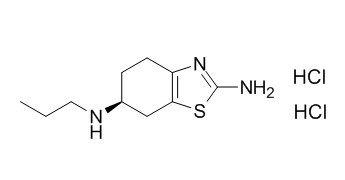Pramipexole dihydrochloride
Pramipexole dihydrochloride could be used to treat Parkinson disease.
Inquire / Order:
manager@chemfaces.com
Technical Inquiries:
service@chemfaces.com
Tel:
+86-27-84237783
Fax:
+86-27-84254680
Address:
1 Building, No. 83, CheCheng Rd., Wuhan Economic and Technological Development Zone, Wuhan, Hubei 430056, PRC
Providing storage is as stated on the product vial and the vial is kept tightly sealed, the product can be stored for up to
24 months(2-8C).
Wherever possible, you should prepare and use solutions on the same day. However, if you need to make up stock solutions in advance, we recommend that you store the solution as aliquots in tightly sealed vials at -20C. Generally, these will be useable for up to two weeks. Before use, and prior to opening the vial we recommend that you allow your product to equilibrate to room temperature for at least 1 hour.
Need more advice on solubility, usage and handling? Please email to: service@chemfaces.com
The packaging of the product may have turned upside down during transportation, resulting in the natural compounds adhering to the neck or cap of the vial. take the vial out of its packaging and gently shake to let the compounds fall to the bottom of the vial. for liquid products, centrifuge at 200-500 RPM to gather the liquid at the bottom of the vial. try to avoid loss or contamination during handling.
Phytochem Anal.2024, pca.3319.
Appl. Sci.2020, 10(5),1713.
In Vitro Cellular & Developmental Biology - Plant2022, 58:972-988.
BMC Complement Altern Med.2014, 14:352
Kor. J. Herbol.2019, 34(2):59-66
J Sep Sci.2018, 41(11):2488-2497
Sci Rep.2023, 13(1):14594.
Nutr Res Pract.2023, 17(4):670-681.
University of Manitoba2023, 37433.
Toxicol Rep.2021, 8:1131-1142.
Related and Featured Products
Archives of Neurology [01 Jan 2010, 67(1):27-32]
Effects of a dopamine agonist on the pharmacodynamics of levodopa in Parkinson disease.[Pubmed:
20065126]
Treatment of Parkinson disease commonly includes levodopa and dopamine agonists; however, the interaction of these 2 drugs is poorly understood. To examine the effects of a dopamine agonist on the motor response to levodopa.
METHODS AND RESULTS:
Double-blind, randomized, placebo-controlled, crossover clinical trial. Ambulatory academic referral center. Patients Thirteen patients with idiopathic Parkinson disease taking levodopa and experiencing motor fluctuations and dyskinesia. Eligible individuals were randomly assigned to receive Pramipexole dihydrochloride or placebo for 4 weeks followed by a 2-hour intravenous levodopa infusion on consecutive days at 2 rates and with blinded assessments. They were then crossed over to the alternate oral therapy for 4 weeks followed by levodopa infusion and reassessment. Change in finger-tapping speed, measured using the area under the curve (AUC) for finger taps per minute across time; peak finger-tapping speed; duration of response; time to "ON" (defined as a 10% increase in finger-tapping speed above baseline); walking speed; and dyskinesia AUC. Pramipexole with levodopa infusion increased finger-tapping speed beyond the change in baseline by a mean (SE) of 170 (47.2) per minute x minutes (P = .006) and more than doubled the AUC for finger-tapping speed. Pramipexole increased peak finger-tapping speed by a mean (SE) of 18 (8.5) taps per minute (P = .02) and improved mean (SE) walking speed (15.9 [0.70] vs 18.9 [0.70] seconds, P = .004). Pramipexole prolonged duration of response after levodopa infusion and shortened time to ON. Pramipexole increased mean (SE) baseline dyskinesia scores (26.0 [5.85] vs 12.1 [5.85] points, P = .05) and peak dyskinesia scores with levodopa infusion.
CONCLUSIONS:
Pramipexole augmented the motor response to levodopa beyond a simple additive effect and increased the severity of levodopa-induced dyskinesia. When considering a combination of these therapies, an appropriate balance should be maintained regarding gain of motor function vs worsening of dyskinesia.
J Pharm Biomed Anal. 2006 Jun 16;41(4):1152-6. Epub 2006 Mar 31.
Validated chiral liquid chromatographic method for the enantiomeric separation of Pramipexole dihydrochloride monohydrate.[Pubmed:
16580170]
METHODS AND RESULTS:
A chiral liquid chromatographic method was developed for the enantiomeric resolution of Pramipexole dihydrochloride monohydrate, (S)-2-amino-4,5,6,7-tetra-hydro-6-(propylamino) benzothiazole dihydrochloride monohydrate, a dopamine agonist in bulk drugs. The enantiomers of Pramipexole dihydrochloride monohydrate were resolved on a Chiralpak AD (250 mm x 4.6 mm, 10 microm) column using a mobile phase system containing n-hexane:ethanol:diethylamine (70:30:0.1, v/v/v). The resolution between the enantiomers was found not less than eight. The presence of diethylamine in the mobile phase has played an important role in enhancing chromatographic efficiency and resolution between the enantiomers. The developed method was extensively validated and proved to be robust. The limit of detection and limit of quantification of (R)-enantiomer were found to be 300 and 900 ng/ml, respectively for 20 microl injection volume. The percentage recovery of (R)-enantiomer was ranged from 97.3 to 102.0 in bulk drug samples of Pramipexole dihydrochloride monohydrate.
CONCLUSIONS:
Pramipexole dihydrochloride monohydrate sample solution and mobile phase were found to be stable for at least 48 h. The proposed method was found to be suitable and accurate for the quantitative determination of (R)-enantiomer in bulk drugs.



